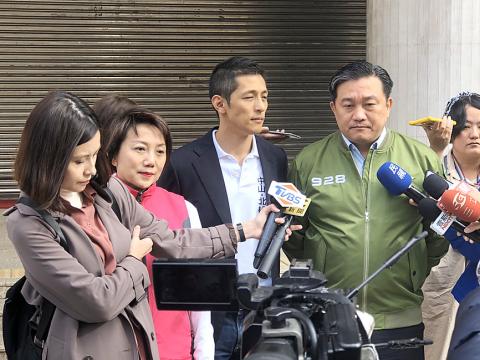Democratic Progressive Party (DPP) legislative candidate Enoch Wu (吳怡農) on Thursday evening launched a Facebook campaign to prevent retired lieutenant general Wu Sz-huai (吳斯懷) — No. 4 on the Chinese Nationalist Party’s (KMT) legislator-at-large list — from remaining a nominee to the Legislative Yuan.
Enoch Wu — who seeks to represent Taipei’s Zhongshan (中山) and Songshan (松山) districts — wrote that the goal of the Facebook campaign is to prevent the KMT from getting more than 1.59 million votes in the Jan. 11 legislative elections, which would prevent Wu Sz-huai from obtaining a legislative seat.
In the nation’s single-district, two-vote system, Taiwanese cast one vote for a district legislator and another for a party, from which the legislator-at-large seats are apportioned among the parties. A party must receive at least 5 percent of the total party vote to be allocated at-large seats.

Photo courtesy of Enoch Wu’s campaign office
The Facebook campaign gained nearly 30,000 likes and thousands of shares overnight, Enoch Wu told a news conference yesterday, which was also attended by DPP Legislator Wang Ting-yu (王定宇) and DPP legislator-at-large candidate Fan Yun (范雲).
Wang said that the KMT’s inclusion of the president of the 800 Heroes for the Republic of China Association on its list shows disrespect for Taiwanese taxpayers, as he attended a major event featuring a speech by Chinese President Xi Jinping (習近平) and has also offered military advice to China on a TV program.
Wang was referring to Wu Sz-huai’s participation in a 2016 event in Beijing — where he was observed to stand during the playing of the Chinese national anthem — and his recommendations to the People’s Liberation Army in a TV program broadcast by Hong Kong-based Phoenix Satellite TV on how it could best fight US forces.
“Wu Sz-huai’s existence in the legislature poses the biggest threat to Taiwanese,” Wang said.

The US government has signed defense cooperation agreements with Japan and the Philippines to boost the deterrence capabilities of countries in the first island chain, a report by the National Security Bureau (NSB) showed. The main countries on the first island chain include the two nations and Taiwan. The bureau is to present the report at a meeting of the legislature’s Foreign Affairs and National Defense Committee tomorrow. The US military has deployed Typhon missile systems to Japan’s Yamaguchi Prefecture and Zambales province in the Philippines during their joint military exercises. It has also installed NMESIS anti-ship systems in Japan’s Okinawa

‘WIN-WIN’: The Philippines, and central and eastern European countries are important potential drone cooperation partners, Minister of Foreign Affairs Lin Chia-lung said Minister of Foreign Affairs Lin Chia-lung (林佳龍) in an interview published yesterday confirmed that there are joint ventures between Taiwan and Poland in the drone industry. Lin made the remark in an exclusive interview with the Chinese-language Liberty Times (the Taipei Times’ sister paper). The government-backed Taiwan Excellence Drone International Business Opportunities Alliance and the Polish Chamber of Unmanned Systems on Wednesday last week signed a memorandum of understanding in Poland to develop a “non-China” supply chain for drones and work together on key technologies. Asked if Taiwan prioritized Poland among central and eastern European countries in drone collaboration, Lin

ON ALERT: Taiwan’s partners would issue warnings if China attempted to use Interpol to target Taiwanese, and the global body has mechanisms to prevent it, an official said China has stationed two to four people specializing in Taiwan affairs at its embassies in several democratic countries to monitor and harass Taiwanese, actions that the host nations would not tolerate, National Security Bureau (NSB) Director-General Tsai Ming-yen (蔡明彥) said yesterday. Tsai made the comments at a meeting of the legislature’s Foreign Affairs and National Defense Committee, which asked him and Minister of National Defense Wellington Koo (顧立雄) to report on potential conflicts in the Taiwan Strait and military preparedness. Democratic Progressive Party (DPP) Legislator Michelle Lin (林楚茵) expressed concern that Beijing has posted personnel from China’s Taiwan Affairs Office to its

BACK TO WORK? Prosecutors said they are considering filing an appeal, while the Hsinchu City Government said it has applied for Ann Kao’s reinstatement as mayor The High Court yesterday found suspended Hsinchu mayor Ann Kao (高虹安) not guilty of embezzling assistant fees, reducing her sentence to six months in prison commutable to a fine from seven years and four months. The verdict acquitted Kao of the corruption charge, but found her guilty of causing a public official to commit document forgery. The High Prosecutors’ Office said it is reviewing the ruling and considering whether to file an appeal. The Taipei District Court in July last year sentenced Kao to seven years and four months in prison, along with a four-year deprivation of civil rights, for contravening the Anti-Corruption